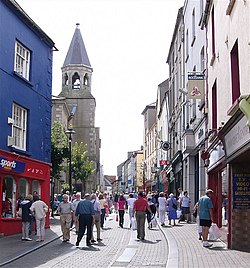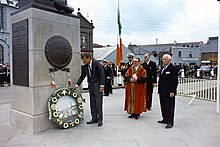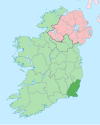Wexford
Wexford
Loch Garman | |
|---|---|
 Main Street, Wexford | |
| Motto(s): Per Aquam et Ignem 'Through Water and Fire' | |
| Coordinates: 52°20′03″N 6°27′27″W / 52.3342°N 6.4575°W | |
| Country | Ireland |
| Province | Leinster |
| County | County Wexford |
| Dáil Éireann | Wexford |
| EU Parliament | South |
| Elevation | 1 m (3 ft) |
| Population (2016)[1] | |
| • Urban | 20,188 |
| Time zone | UTC±0 (WET) |
| • Summer (DST) | UTC+1 (IST) |
| Eircode routing key | Y35 |
| Telephone area code | +353(0)53 |
| Irish Grid Reference | T051213 |
| Website | www |
Wexford (Irish: Loch Garman)[2] is the county town of County Wexford, Ireland. Wexford lies on the south side of Wexford Harbour, the estuary of the River Slaney near the southeastern corner of the island of Ireland. The town is linked to Dublin by the M11/N11 National Primary Route; and to Rosslare Europort, Cork and Waterford by the N25. The national rail network connects it to Dublin and Rosslare Europort. It had a population of 20,188 according to the 2016 census.[1]
History



The town was founded by the Vikings in about 800 AD. They named it Veisafjǫrðr, meaning "inlet of the mud flats", and the name has changed only slightly into its present form. "Vei" in modern Norwegian means "Way". So 'Veisafjǫrðr' could have meant "inlet of the way" or "Way Fjord". According to a story recorded in the Dindsenchas, the name "Loch Garman" comes from a man named Garman mac Bomma Licce who was chased to the river mouth and drowned as a consequence of stealing the queen's crown from Temair during the feast of Samhain.
For about three hundred years it was a Viking town, a city state, largely independent and owing only token dues to the Irish kings of Leinster. However, in May 1169 Dermot MacMurrough, King of Leinster and his Norman ally, Robert Fitz-Stephen besieged Wexford. The Norse inhabitants resisted fiercely until the Bishop of Ferns persuaded them to accept a settlement with Dermot.
Wexford was an Old English settlement in the Middle Ages. An old dialect of English, known as Yola, was spoken uniquely in Wexford up until the 19th century. The Yola name for Wexford was Weiseforthe.[3]
Following the Crusades, the Knights Templar had a presence in Wexford. Up to the present, their name is perpetuated in the old Knights' Templars' chapel yard of St. John's Cemetery, on Wexford's Upper St. John's Street.
County Wexford produced strong support for Confederate Ireland during the 1640s. A fleet of Confederate privateers was based in Wexford town, consisting of sailors from Flanders and Spain as well as local men. Their vessels raided English Parliamentarian shipping, giving some of the proceeds to the Confederate government in Kilkenny. As a result, the town was sacked by the English Parliamentarians during the Cromwellian conquest of Ireland in 1649. Many of its inhabitants were killed and much of the town was burned. In 1659 Solomon Richards was appointed Governor, but he was dismissed and imprisoned following the Restoration the next year.
County Wexford was the centre of the 1798 rebellion against British rule. Wexford town was held by the rebels throughout the Wexford Rebellion and was the scene of a notorious massacre of local loyalists by the United Irishmen, who executed them with pikes on Wexford bridge.


Redmond Square, near the railway station, commemorates the elder John Edward Redmond (1806–1865) who was Liberal MP for the city of Wexford. The inscription reads: "My heart is with the city of Wexford. Nothing can extinguish that love but the cold soil of the grave." His nephew William Archer Redmond (1825–1880) sat as an MP in Isaac Butt's Home Rule Party from 1872 until 1880. Willie Redmond sat as an MP for Wexford from 1883 until 1885. The younger John Redmond, was a devoted follower of Charles Stewart Parnell and leader of the Irish Parliamentary Party until his death in April 1918. He is interred in the Redmond family vault, at the old Knights' Templars' chapel yard of St. John's Cemetery, Upper St. John's Street.
Redmond Park was formally opened in May 1931 as a memorial to Willie Redmond,[4] who died in 1917 while serving with the 16th (Irish) Division during the Messines offensive and was buried on the Western Front.
Culture
Wexford hosts the Wexford Opera Festival every October. Dr Tom Walsh started the festival in 1951, and it has since grown into the internationally recognised festival it is today. A fireworks display is held every year in conjunction with the festival.
Wexford has a number of music and drama venues including:
- The National Opera House (formerly the Wexford Opera House), developed on the site of the historic Theatre Royal opera house;
- the Dun Mhuire Theatre, which holds community theatre events including music events and hosting shows by Oyster Lane Theatre Group and Wexford Pantomime Society;
- the Wexford Arts Centre, which hosts exhibitions, theatre, music and dance events;
- St. Iberius's Church (Church of Ireland), various concerts are held here.
- Red Books, an independent bookshop in St Peter's Square which hosts regular LiveLit, music and spoken word events, as well as book launches, and writers groups.
Wexford is the home of several youth and senior theatre groups, including the Buí Bolg Street Theatre Company, Oyster Lane Theatre Group, Wexford Pantomime Society, Wexford Light Opera Society and Wexford Drama Group.
The National Lottery Skyfest was held in Wexford in March 2011 included a pyrotechnic waterfall on the towns main bridge spanning 300m.[5] Buí Bolg also performed on the night.[5]
Until the mid-nineteenth century, the Yola language could be heard in Wexford, and a few words still remain in use.
The food of Wexford is also distinct from the rest of Ireland,[citation needed] due to the local cultivation of seafood, smoked cod, mussels and rissoles being token dishes in the region.
Architecture
Notable churches within the town include the "twin churches", Bride Street and Rowe Street with their distinctive spires; St. Iberius Church of Ireland, which dates from the 18th Century; Saint Peter's College, with a chapel designed by Augustus Welby Pugin; and Ann Street Presbyterian church. A former Quaker meeting hall is now a band room in High Street. The twin churches can be seen from any part of Wexford and in 2008, their 150th anniversary were celebrated. The larger twin, on Rowe Street, contains a peal of ten change-ringing bells, cast by Gillett & Johnston in 1930.[6]
More recently,[when?] Wexford has seen the redevelopment of its quay front and a residential development at Clonard village.[citation needed] Also, the relocated offices of the Department of Environment were constructed near Wexford General Hospital on Newtown Road, and opened in 2010.[7]
Economy
Wexford's success as a seaport declined in the first half of the 20th century because of the constantly changing sands of Wexford Harbour.[8] By 1968 it had become unprofitable to keep dredging a channel from the harbour mouth to the quays in order to accommodate the larger ships of the era, so the port closed. The port had been extremely important to the local economy, with coal being a major import and agricultural machinery and grain being exported. The woodworks which fronted the quays and which were synonymous with Wexford were removed in the 1990s as part of a plan to claim the quay as an amenity for the town as well as retaining it as a commercially viable waterfront.
In the early 20th century, a new port was built about 20 kilometres (12 mi) to the south at Rosslare Harbour, now known as Rosslare Europort. This is a deepwater harbour, unaffected by tides and currents. All major shipping now uses this port and Wexford Port is used only by fishing boats and leisure vessels.

Johnstown Castle, approximately 6 km from Wexford town, is headquarters to Teagasc, the Environmental Protection Agency and the Department of Agriculture, Food and the Marine.
Major private sector employers in and around the town include Wexford Creamery, Celtic Linen, Wexford Viking Glass, Parker Hannifin IPDE, Waters Technology, Kent Stainless, Equifax and BNY Mellon. Coca-Cola operates a research plant employing up to 160.[9] Eishtec operates a callcenter for British mobile operator EE that employs 250.[10] Pamela Scott, A-wear and other retailers operate in the town. Public sector employers include Wexford County Council and Wexford General Hospital.
Places of interest

Curracloe Beach, approximately 10 km north of Wexford town, was the location in 1997 for the opening scenes of Saving Private Ryan.[11]
The Irish National Heritage Park at Ferrycarrig includes various exhibits spanning 9000 years of Irish history, allowing the visitor to wander around re-creations of historic Irish dwelling including crannogs, Viking houses and Norman forts.[12] The grounds also feature the archaeological site of Newtown, considered the first Norman fortification in Ireland.[13]
The Wexford Wildfowl Reserve is a Ramsar site based on mudflats, (known locally as slobland), just outside Wexford.[14] It is a migratory stop-off point for thousands of ducks, geese, swans and waders. Up to 12,000 (50% of the world's population) of Greenland white-fronted geese spend the winter on the Wexford slobs. There is a visitor centre with exhibitions and an audio-visual show.[15]
Transport
Wexford O'Hanrahan railway station opened on 17 August 1874.[16] On 10 April 1966 the station was named after Michael O'Hanrahan, one of the executed leaders of the 1916 Easter Rising. The railway line from Dublin to Rosslare Harbour runs along the quayside on the north-eastern edge of the town. In 2010 the Rosslare Strand-Waterford rail services were suspended, due to budget cuts at Irish Rail.[17]
Wexford is also served by local and national bus networks, primarily Bus Éireann, Wexford Bus and Ardcavan Bus. There are also many local taxi and hackney providers. Wexford Bus serves Wexford Town and rural County Wexford.
Rosslare Europort is 19 kilometres south of Wexford. Car ferries run between Fishguard and Pembroke in Wales and Cherbourg and Roscoff in France. The ferry companies operating on these routes are Stena Line and Irish Ferries. Foot passengers can use the SailRail tickets from Wexford O'Hanrahan station via Rosslare Europort and Fishguard Harbour to reach Swansea, Cardiff Central and onwards including London Paddington.
The closest airport to Wexford is Waterford Airport which is approximately one hour away (70 km). Dublin Airport and Cork Airport are both approximately two-and-a-half hours away.
The town also has a shuttle-bus service which has stops at the town's main facilities.
Sport
Association football
The Wexford football club was admitted to the League of Ireland in 2007. Wexford was the first Wexford-based club to take part in the competition. The club was the brainchild of former property developer Mick Wallace TD, who funded the construction of a complex for the new team's home at Newcastle, Ferrycarrig. In 2015, the team won promotion to the Irish Premier League, unfortunately being relegated the following year The club launched Wexford Youths WFC, a Women's National League team, in 2011.
Gaelic football
Wexford is also home to several Gaelic Athletic Association clubs. Though the town was traditionally associated with Gaelic football, with six teams providing ample outlets for its youngsters, it was not until 1960 that hurling took its foothold, with much due to local man Oliver "Hopper" McGrath's contribution to the county's All-Ireland Hurling Final triumph over the then-champions Tipperary. Having scored an early second-half goal to effectively kill off the opposition, McGrath went on to be the first man from the town of Wexford to receive an All-Ireland Hurling winner's
Although the team has not achieved county senior football success since 1956, Volunteers ("the Vols") of Wexford Town hold a record eleven county senior titles, as well as six minor titles. Other notable Gaelic football clubs in the town are Sarsfields, St. Mary's of Maudlintown, Clonard and St. Joseph's.
Hurling
One of the town's local hurling clubs, Faythe Harriers, holds a record fifteen county minor championships, having dominated the minor hurling scene in the 1950s, late 1960s and early 1970s. The senior side has also won five Wexford Senior Hurling Championships.
Other sports
Wexford Golf Club's clubhouse and course were finished in 2006 and 2007 respectively.[citation needed]
Wexford has one rugby club, called the Wexford Wanderers RFC.
Ireland's former boxing head coach and Olympian Billy Walsh is a native of Wexford town and has been involved in the training of underage level boxers with local club St. Ibars/Joseph's.[citation needed]
Education
There are five secondary schools serving the population of the town. These are Wexford CBS, Coláiste Éamonn Rís (boys' school); Loreto Secondary School (girls' school); St Peter's College (boys' school); Presentation Secondary School (girls' school); and The Vocational College/Selskar College (mixed school).
People
- John Banville, writer
- Eoin Colfer, writer
- Robert McClure, Arctic Explorer
- Brendan Corish, politician
- Thomas D'Arcy McGee, Canadian politician
- Kevin Doyle, footballer
- Jane Elgee 'Speranza', mother of Oscar Wilde
- Mary Fitzgerald (trade unionist)
- Gerald Fleming, meteorologist[18]
- Brendan Howlin, politician
- William Kenealy, recipient of the Victoria Cross
- Larry Kirwan, writer and musician
- William Lamport, Irish soldier upon whom Zorro is said to be based
- Michael Londra, singer
- Declan Lowney, director
- Billy Roche, playwright
- Dick Roche, politician
- Jem Roche, boxer
- Declan Sinnott, musician
- John Sinnott, recipient of the Victoria Cross
- Pierce Turner, singer-songwriter
- John Welsh, writer
- Cry Before Dawn, rock band who found success in the late 1980s, hails from Wexford
Twinning
Wexford is twinned with the following places:
 Annapolis, MD, United States[19]
Annapolis, MD, United States[19] Couëron, Loire-Atlantique, Pays de la Loire, France[20]
Couëron, Loire-Atlantique, Pays de la Loire, France[20] Lugo, Ravenna, Emilia-Romagna, Italy[21]
Lugo, Ravenna, Emilia-Romagna, Italy[21] Staten Island, New York, NY, United States
Staten Island, New York, NY, United States Yanga, Veracruz, Mexico[22]
Yanga, Veracruz, Mexico[22]
See also
References
- ^ a b "Sapmap Area - Settlements - Wexford". Census 2016. CSO. 2016. Retrieved 12 January 2018.
- ^ "Bunachar Logainmneacha na hÉireann". Logainm.ie.
- ^ Shiels, Damian. "Column: Yola and Fingalian – the forgotten ancient English dialects of Ireland".
- ^ "A Guide To Redmond Park".
- ^ a b Kane, Conor (21 March 2011). "Pyrotechnic spectacle banishes the gloom". Irish Times. Archived from the original on 24 September 2015. Retrieved 13 April 2015 – via HighBeam Research.
- ^ "Dove Details". dove.cccbr.org.uk.
- ^ "Press Release - Department of the Environment, Community and Local Government, Wexford". gov.ie. Office of Public Works. Retrieved 26 March 2020.
- ^ "Wexford Quay". Retrieved 21 October 2015.
- ^ "Coca-Cola gets green light - WexfordPeople.ie".
- ^ eishtec.com Archived 3 January 2013 at the Wayback Machine
- ^ "Saving Private Ryan". Filmography. The Irish Film and Television Network. Retrieved 4 April 2011.
- ^ "The Park". The Irish National Park. Retrieved 13 December 2012.
- ^ "Excavations | The Irish Archaeology Field School". iafs.ie. Retrieved 13 July 2018.
- ^ "Wexford Wildfowl Reserve - About Us". National Parks & Wildlife Service. Retrieved 13 December 2012.
- ^ "The Wexford Wildfowl Reserve". Office of Public Works (OPW). Archived from the original on 30 September 2012. Retrieved 13 December 2012.
- ^ "Wexford station" (PDF). Railscot - Irish Railways. Retrieved 7 September 2007.
- ^ "Waterford-Rosslare Reports - National Transport Authority".
- ^ RTE.ie Archived 2 June 2010 at the Wayback Machine, The Weather Team on the RTÉ website
- ^ "Our Town and History". Archived from the original on 21 October 2014.
- ^ "Jumeblages" [Twinnings] (in French). Archived from the original on 13 April 2014.
- ^ "Twinning Pact between the towns of Wexford and Lugo" (PDF).
- ^ "Llegan funcionarios de Irlanda a Yanga" [Irish officials arrive to Yanga] (in Spanish).
Further reading
- Billy Colfer (20 April 2008). Wexford: A Town and Its Landscape. Cork University Press. ISBN 9781859184295.
External links
 Media related to Wexford at Wikimedia Commons
Media related to Wexford at Wikimedia Commons- . Collier's New Encyclopedia. 1921.




